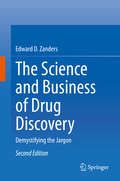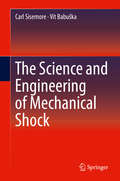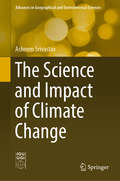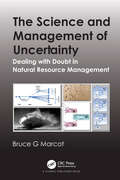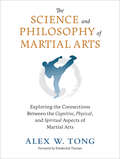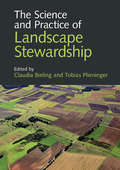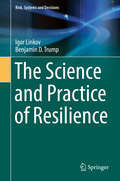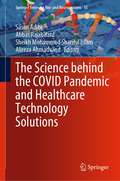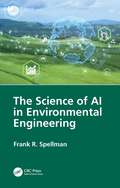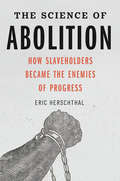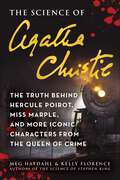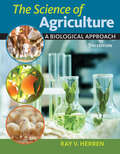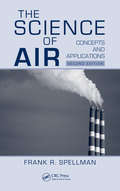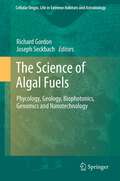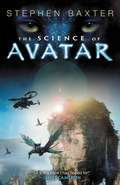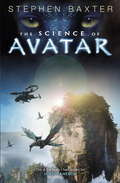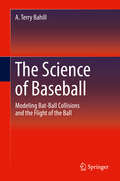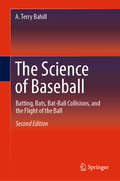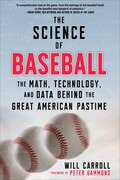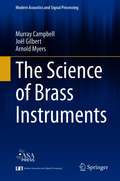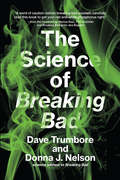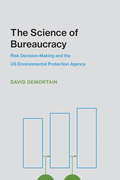- Table View
- List View
The Science and Business of Drug Discovery: Demystifying the Jargon
by Edward D. ZandersThe Science and Business of Drug Discovery is written for those who want to learn about the biopharmaceutical industry and its products whatever their level of technical knowledge. Its aim is to demystify the jargon used in drug development, but in a way that avoids over simplification and the resulting loss of key information. Each of the twenty chapters is illustrated with figures and tables which clarify some of the more technical points being made. Also included is a drug discovery case history which draws the relevant material together into a single chapter. In recognizing that it is difficult to navigate through the many external resources dealing with drug development, the book has been written to guide the reader towards the most appropriate information sources, including those listed in the two appendices.The following topics are covered:Different types of drugs: from small molecules to stem cellsBackground to chemistry of small and large moleculesHistorical background to drug discovery, pharmacology and biotechnologyThe drug discovery pipeline: from target discovery to marketed medicineCommercial aspects of drug discoveryChallenges to the biopharmaceutical industry and its responsesMaterial of specific interest to technology transfer executives, recruiters and pharmaceutical translators
The Science and Engineering of Mechanical Shock
by Carl Sisemore Vít BabuškaThis book fills a unique position in the literature as a dedicated mechanical shock analysis book. Because shock events can be extremely damaging, mechanical shock is an important topic for engineers to understand. This book provides the reader with the tools needed to quantitatively describe shock environments and their damage potential on aerospace, civil, naval and mechanical systems. The authors include the relevant history of how shock testing and analysis came to its current state and a discussion of the different types of shock environments typically experienced by systems. Development of single-degree-of-freedom theory and the theory of the shock response spectra are covered, consistent with treatment of shock spectra theory in the literature. What is unique is the expansion to other types of spectra including less common types of shock spectra and energy spectra methods using fundamental principles of structural dynamics. In addition, non-spectral methods are discussed with their applications. Non-spectral methods are almost completely absent from the current books on mechanical shock. Multi-degree-of-freedom shock spectra and multi-degree-of-freedom testing are discussed and the theory is developed. Addressing an emerging field for laboratory shock testing, the authors bring together information currently available only in journals and conference publications. The volume is ideal for engineers, structural designers, and structural materials fabricators needing a foundation to practically analyze shock environments and understand their role in structural design.
The Science and Impact of Climate Change (Advances in Geographical and Environmental Sciences)
by Asheem Srivastav<p>This volume provides a holistic and concise overview of the complex science of climate change involving the interplay of multiple factors. It also acts as a primer and a one-source reference to all the aspects of climate change, allowing researchers to understand the complexity of this science and to see the larger picture, thereby aiming towards holistic solutions. <p>Beginning in the second half of the twentieth century, the impacts of climate change have been the worst nightmare to hit humanity so fiercely, causing loss of human life and irreparable destruction to natural and man-made infrastructure in many parts of the world. The difference between climate change now and in the past is that of sudden and disproportionate disruption of the natural energy dynamics by the changing consumption patterns of billions of human beings who, in their quest for economic superiority, have polluted the terrestrial and aquatic ecosystems. The picture that emerges from the exhaustive analysis of international data drawn from the most reliable sources indicates that we have possibly gained access to the gateway of extinction and it is time that we take corrective steps immediately. <p>The book’s chapters not only provide an overview of climate change science but also include detailed discussion on current research. This unique analytical text is suitable for conservation environmentalists, researchers, and academicians working in the field, along with policy makers, research and training institutes, and nongovernment organizations.</p>
The Science and Management of Uncertainty: Dealing with Doubt in Natural Resource Management
by Bruce G. MarcotUncertainty can take many forms, can be represented in many ways, and can have important implications in decision-making and policy development. This book provides a rigorous scientific framework for dealing with uncertainty in real-world situations, and provides a comprehensive study of concepts, measurements, and applications of uncertainty in ecological modeling and natural resource management. The focus of this book is on the kinds and implications of uncertainty in environmental modeling and management, with practical guidelines and examples for successful modeling and risk analysis in the face of uncertain conditions and incomplete information. Provided is a clear classification of uncertainty; methods for measuring, modeling, and communicating uncertainty; practical guidelines for capturing and representing expert knowledge and judgment; explanations of the role of uncertainty in decision-making; a guideline to avoiding logical fallacies when dealing with uncertainty; and several example cases of real-world ecological modeling and risk analysis to illustrate the concepts and approaches. Case topics provide examples of structured decision-making, statistical modeling, and related topics. A summary provides practical next steps that the reader can take in analyzing and interpreting uncertainty in real-world situations. Also provided is a glossary and a suite of references.
The Science and Philosophy of Martial Arts: Exploring the Connections Between the Cognitive, Physical, and Spiritual Aspects of Martial Arts
by Alex W. TongThrough the lenses of Shotokan Karate and biomedicine, sensei and biomedical scientist Alex W. Tong shows readers how body, mind, and spirit can be developed through martial arts practice.Through the practice of martial arts, a person can realize their full potential--not only in body, but in mind and spirit. The Science and Philosophy of Martial Arts shows readers how. Author, sensei, and biomedical scientist Alex W. Tong delves into the physical, mental, and spiritual components of martial arts and integrates contemporary sports psychology, kinesiology, and neuroscience into a nuanced and illuminating understanding of what martial arts practice can be. Structured into three sections, Tong discusses: • The Mind: The dao of martial arts, mental tranquility, contemporary neuroscience, and warming up the brain • The Body: Posture and stance, breathing in martial arts, and the physics of mastery and effort • The Spirit: Soul, spirit, and moving zen; nature and manifestations of the spirit Each section includes observations on martial arts origins, physiology, and tangible results on martial arts training. Blending traditional and contemporary approaches, knowledge, and research, The Science and Philosophy of Martial Arts builds a vision of practice that elevates physical performance, awareness, decisiveness, and strength of spirit.
The Science and Practice of Landscape Stewardship
by Tobias Plieninger Claudia BielingImproving the dynamic relationship between nature and human well-being is a pressing issue of our time. Landscapes embody this tight interconnectedness and serve as unique sustainability learning hubs, showcased by the global rise of place-based and holistic landscape stewardship initiatives. Incorporating these exciting developments, this book explores the principles of landscape stewardship and their function in fields such as agriculture, ecological restoration and urban green infrastructure. It provides insights into the challenges and the potential of landscape stewardship and identifies future paths for the science and practice of landscape-related sustainability efforts. Aligning analytical perspectives with practical applications, it brings together contributions from leading scholars and innovative models of landscape stewardship from all around the world, making it an essential resource for anyone interested in developing sustainable human-nature relationships.
The Science and Practice of Resilience (Risk, Systems and Decisions)
by Igor Linkov Benjamin D. TrumpThis book offers a comprehensive view on resilience based upon state-of-the-science theories and methodological applications that resilience may fill. Specifically, this text provides a compendium of knowledge on the theory, methods, and practice of resilience across a variety of country and case contexts, and demonstrates how a resilience-based approach can help further improved infrastructure, vibrant societies, and sustainable environments and ecologies, among many others. Resilience is a term with thousands of years of history. Only recently has resilience been applied to the management of complex interconnected systems, yet its impact as a governing philosophy and an engineering practice has been pronounced. Colloquially, resilience has been used as a synonym for ‘bouncing back’. Philosophically and methodologically, however, it is much more. In a world defined by interconnected and interdependent systems such as water, food, energy, transportation, and the internet, a sudden and unexpected disruption to one critical system can lead to significant challenges for many others. The Science and Practice of Resilience is beneficial for those seeking to gain a rich knowledge of the resilience world, as well as for practitioners looking for methods and tools by which resilience may be applied in real-world contexts.
The Science and Practice of Welding: Welding Science and Technology, Volume 1
by A. C. DaviesThe Science and Practice of Welding, now in its tenth edition, is an introduction to the theory and practice of welding processes and their applications. Volume 1, Welding Science and Technology, explains the basic principles of physics, chemistry and metallurgy applied to welding. The section on electrical principles includes a simple description of the silicon diode and resistor, the production and use of square wave, and one-knob stepless control of welding current. There is a comprehensive section on non-destructive testing (NDT) and destructive testing of welds and Crack Tip Opening Displacement Testing. The text has been brought completely up-to-date and now includes a new chapter devoted to the Inverter power unit, and duplex stainless steel has been included in the list of materials described. Volume 2, The Practice of Welding, is a comprehensive survey of the welding methods in use today and includes up-to-date information on all types of welding methods and tools, including manula metal are welding(MMA), gas shielded metal are welding(MIG and MAG), tungsten electrode inert gas shielded welding processes(TIG) and plasma are processes, resistance welding and flash butt welding, oxy-acetylene welding. The book also has a chapter on cutting processes. This new edition has been brought right up-to-date with a new chapter on the welding of plastics, and new sections on the welding of duplex stainless steel and air plasma cutting. As in previous editions, the appendice brings together a wealth of essential information, including British and American welding symbols, tables of conversion, informatin on propriety welding gases and mixtures, testing practices, safety features and tables of brazing alloys and fluxes. Both volumes contain numerous questions of the type set craftsman and technician grade of the City and Guilds of London Institute examinations.
The Science and Technology of Industrial Water Treatment
by Zahid AmjadMineral scale deposits, corrosion, suspended matter, and microbiological growth are factors that must be controlled in industrial water systems. Research on understanding the mechanisms of these problems has attracted considerable attention in the past three decades as has progress concerning water treatment additives to ameliorate these concerns.
The Science behind the COVID Pandemic and Healthcare Technology Solutions (Springer Series on Bio- and Neurosystems #15)
by Abbas Rajabifard Sasan Adibi Sheikh Mohammed Shariful Islam Alireza AhmadvandThis book offers a timely review of modern technologies for health, with a special emphasis on wireless and wearable technologies, GIS tools and machine learning methods for managing the impacts of pandemics. It describes new strategies for forecasting evolution of pandemics, optimizing contract tracing, and for detection and diagnosis of diseases, among others. Written by researchers and professionals with different backgrounds, this book offers a extensive information and a source of inspiration for physiologists, engineers, IT scientists and policy makers in the health and technology sector.
The Science of AI in Environmental Engineering
by Frank R. SpellmanThis book explores the integration of artificial intelligence (AI) in environmental engineering, emphasizing the unique challenges and approaches required for the accurate modeling of physical phenomena. It clearly explains how AI should be developed and applied specifically in this field, offering definitions, examples, and practical guidance. It is designed to be accessible, featuring tables, figures, and illustrations to simplify complex topics like water hydraulics, air pollution, waste management, and more. Suitable for professionals in the field and students, this book explains the benefits of AI in environmental engineering and discusses the latest developments and environmental concerns.This book: Explains the nexus between artificial intelligence and environmental engineering Includes illustrative problems and solutions commonly used in current environmental practices Covers the latest AI developments and how they can be effectively applied to solve modern engineering challenges
The Science of Abolition: How Slaveholders Became the Enemies of Progress
by Eric HerschthalA revealing look at how antislavery scientists and Black and white abolitionists used scientific ideas to discredit slaveholders In the context of slavery, science is usually associated with slaveholders&’ scientific justifications of racism. But abolitionists were equally adept at using scientific ideas to discredit slaveholders. Looking beyond the science of race, The Science of Abolition shows how Black and white scientists and abolitionists drew upon a host of scientific disciplines—from chemistry, botany, and geology, to medicine and technology—to portray slaveholders as the enemies of progress. From the 1770s through the 1860s, scientists and abolitionists in Britain and the United States argued that slavery stood in the way of scientific progress, blinded slaveholders to scientific evidence, and prevented enslavers from adopting labor‑saving technologies that might eradicate enslaved labor. While historians increasingly highlight slavery&’s centrality to the modern world, fueling the rise of capitalism, science, and technology, few have asked where the myth of slavery&’s backwardness comes from in the first place. This book contends that by routinely portraying slaveholders as the enemies of science, abolitionists and scientists helped generate that myth.
The Science of Agatha Christie: The Truth Behind Hercule Poirot, Miss Marple, and More Iconic Characters from the Queen of Crime (The Science of)
by Meg Hafdahl Kelly FlorenceUncover the theories behind Dame Agatha Christie's most thrilling mysteries: Murder on the Orient Express, Death on the Nile, The A.B.C. Murders, and so much more! Gothic media moguls Meg Hafdahl and Kelly Florence, authors of The Science of Stephen King and co-hosts of the Horror Rewind podcast called &“the best horror film podcast out there&” by Film Daddy, present a guide to the Agatha Christie stories and supersleuths we all know and love. Through interviews, literary and film analysis, and bone-chilling discoveries, The Science of Agatha Christie uncovers the science behind the sixty-six detective novels and fourteen short story collections that have become an integral part of the modern murder mystery, answering such questions as: What is the science behind the poisons used to commit murders in Agatha Christie&’s stories? When did crime investigation become more common as seen in Murder on the Orient Express? Has science made it possible to uncover the truth behind the investigative powers of Hercule Poirot and Miss Marple? How did Agatha Christie use isolated settings to best explore the psychology of her characters? Join Kelly and Meg as they discover why sometimes the impossible must be possible!
The Science of Agriculture: A Biological Approach (Mindtap Course List Series)
by Ray V. HerrenTHE SCIENCE OF AGRICULTURE: A BIOLOGICAL APPROACH, Fifth Edition, masterfully introduces the biological sciences and explores the influences of these sciences on modern agricultural practices and the agricultural industry. <p><p>Reader-friendly and superbly illustrated, this highly practical text explains not only the "how" of agriculture, but also the "why" behind agriscience, presenting information on plant and animal systems, soils, cell functions, genetics, genetic engineering, plant and animal reproduction, entomology, biotechnology, and environmental concerns. <p><p>Additionally, the text spotlights career opportunities and discusses new directions in agriculture, including topics such as no-till crops, high-pressure processing in food preservation, fracking, and more, to further engage you with today's agricultural world.
The Science of Air: Concepts and Applications, Second Edition
by Frank R. SpellmanHailed on first publication as a masterful review of the topic, The Science of Air: Concepts and Applications quickly became a standard resource in the field. Clearly written and user-friendly, the second edition continues to provide the scientific underpinnings of the essence of air. Major expansions include:Air math and physicsAir flow parameters
The Science of Algal Fuels
by Richard Gordon Joseph SeckbachThis volume, The Science of Algal Fuels (volume 25 of COLE), contains 26 chapters dealing with biofuels contributed by experts from numerous countries and covers several aspects of algal products, one being "oilgae from algae," mainly oils and fuels for engines. Among the prominent algal groups that participate in this process are the diatoms and green algae (Chlorophyceae). Their metabolism and breeding play an important role in biomass and extraction of crude oil and algal fuel. There is a strong relation between solar energy influencing algal culture and the photobiology of lipid metabolism. Currently, many international meetings and conferences on biofuel are taking place in many countries, and several new books and proceedings of conferences have appeared on this topic. All this indicates that this field is "hot" and in the forefront of applied bioscience.
The Science of Aliens: The Real Science Behind the Gods and Monsters from Space and Time (The Science of)
by Mark BrakeDiscover the real science behind 2001, ET, Signs, and all your favorite fictional alien civilizations.As space telescopes continue to search for life in this unearthly Universe, the crucial questions remain unanswered. Are we awake to the revolutionary effects on human society and science that alien contact will bring? And how is it possible to imagine the unknown? The Science of Aliens tells the compelling story of how the portrayal of alien life has evolved over time.Taking examples from science, film, and fiction, this book showcases how scholars, filmmakers, and authors have devoted their energies to imagining life beyond this Earth. From Copernicus to Kubrick, The Science of Aliens is a fascinating account for anyone interested in extraterrestrials.Otherworldly topics include:What Xenomorphs from Alien and Na&’vi from Avatar have in commonDarwin among aliensExtraterrestrials in Einstein&’s skyAliens in our space ageAnd so much moreVisualize the unknown and redefine your place in a changing cosmos with The Science of Aliens.
The Science of Avatar
by Stephen BaxterAudiences around the world have been enchanted by James Cameron's visionary Avatar, with its glimpse of the Na'vi on the marvelous world of Pandora. But the movie is not entirely a fantasy; there is a scientific rationale for much of what we saw on the screen, from the possibility of travel to other worlds, to the life forms seen on screen and the ecological and cybernetic concepts that underpin the 'neural networks' in which the Na'vi and their sacred trees are joined, as well as to the mind-linking to the avatars themselves.From popular science journalist and acclaimed science fiction author Stephen Baxter, THE SCIENCE OF AVATAR is a guide to the rigorous fact behind the fiction. It will enhance the readers' enjoyment of the movie experience by drawing them further into its imagined world.
The Science of Avatar
by Stephen BaxterJames Cameron's Avatar is the biggest movie of all time. Now the movie's legendary director has leant his support to an exploration of the world of Pandora with bestselling science-fiction author Stephen Baxter. From journeys into deep space to anti-gravity unobtanium, from Pandora's extraordinary flora and fauna to transferring consciousness, Baxter and Cameron reveal that we are often closer to world of Avatar than we might imagine.Stephen Baxter is the master of `what-if?' science fiction. In THE SCIENCE OF AVATAR he's written a book that will appeal to fans of both science-fiction and popular science. THE SCIENCE OF AVATAR will offer fans the unique opportunity to explore the spectacular world of Pandora, from the creator himself.
The Science of Baseball
by A. Terry BahillThis book describes the dynamic collisions between baseballs, softballs, and bats, and the intricate modeling of these interactions, using only Newton’s basic principles and the conservation laws of physics. Veteran baseball science author Terry Bahill explains models for the speed and spin of balls and bats and equations for bat-ball collisions at a level accessible to high school and undergraduate physics students, engineering students, and, most importantly, students of the science of baseball. Unlike other, more technical accounts of these phenomena that exhibit similar rigor, the models presented in this volume use only basic physical principles to describe simple collision configurations. Elucidating the most important factors for understanding bat performance—bat weight, moment of inertia, the coefficient of restitution, and characteristics of humans swinging the bats, Dr. Bahill also explains physical aspects of the ideal bat and the sweet spot.• Explains how to select or design an optimal baseball or softball bat and create models for bat-ball collisions using only fundamental principles of mechanics from high school physics;• Describes the results of the collision between baseball and bat using basic mathematics such as equations for the speed of the ball after the collision, bat speed after the collision, and bat rotation after the collision;•Accessible to high school and undergraduate students as well as non-technical aficionados of the science of baseball. “Dr. Bahill’s book is the perfect tool for teaching how to solve some of baseball’s basic science problems. Using only simple Newtonian principles and the conservation laws, Dr. Bahill explains how to model bat-ball collisions. Also, he derives equations governing the flight of the ball, and proceeds to show what factors affect air density and how this density affects the ball’s flight. And as a unique addition to his fine book, he provides advice for selecting the optimal bat—a surprising bonus!”Dave Baldwin, PhDMajor League pitcher, 1966-1973, lifetime Major League ERA, 3.08 “If I were the General Manger of a baseball team, I would tell my people to write a ten-page paper describing what this book contains that could improve our performance. I think the book provides the foundation for change.”Bruce GissingExecutive VP-Operations (retired) Boeing Commercial Airplanes“[I] had a chance to read your research, and I fully agree with your findings.”Baseball Legend Ted Williams, in a 1984 letter to the author
The Science of Baseball: Batting, Bats, Bat-Ball Collisions, and the Flight of the Ball
by A. Terry BahillThis augmented, new edition adds discussion of the bat’s vertical sweetness gradient, eye-hand cross-dominance, models for the swing of a bat, and accuracy of simulations. The book retains its description of dynamic collisions between baseballs, softballs, and bats, and the intricate modeling of these interactions, using only basic math and physical principles. Veteran baseball science author Terry Bahill explains models for the speed and spin of balls and bats and calculations for bat-ball collisions at a level accessible to most students of the science of baseball. Demystifying the most important factors for understanding bat performance—bat weight, moment of inertia, the coefficient of restitution, and characteristics of humans swinging the bats—Dr. Bahill also explains physical aspects of the optimal bat and the sweet spot.Praise for the First Edition “Dr. Bahill’s book is the perfect tool for teaching how to solve some of baseball’s basic science problems. Using only simple Newtonian principles and the conservation laws, Dr. Bahill explains how to model bat-ball collisions. Also, he derives equations governing the flight of the ball, and proceeds to show what factors affect air density and how this density affects the ball’s flight. And as a unique addition to his fine book, he provides advice for selecting the optimal bat—a surprising bonus!”Dave Baldwin, PhDMajor League pitcher, 1966-1973, lifetime Major League ERA, 3.08 “If I were the General Manger of a baseball team, I would tell my people to write a ten-page paper describing what this book contains that could improve our performance. I think the book provides the foundation for change.”Bruce GissingExecutive VP-Operations (retired) Boeing Commercial Airplanes“[I] had a chance to read your research, and I fully agree with your findings.”Baseball Legend Ted Williams, in a 1984 letter to the author
The Science of Baseball: The Math, Technology, and Data Behind the Great American Pastime
by Will CarrollIn The Science of Baseball, sportswriter and injury expert Will Carroll shows how understanding the science behind the Great American Pastime helps fans appreciate its nuances and that it enhances, not detracts from the greatest game ever invented. Carroll, as well as several experts via interviews, covers topics like what makes the ball break, bounce, and fly; how material science and physics work together to make the bat function; how hitters use physics, geometry, and force to connect; sensors and cameras; injuries; and much more. Baseball aficionados and science geeks alike will better appreciate the game--no matter which teams are playing--after reading this comprehensive book!
The Science of Brass Instruments (Modern Acoustics and Signal Processing)
by Arnold Myers Murray Campbell Joël GilbertThis book provides an in-depth account of the fascinating but far from simple actions and processes that take place when a brass instrument is played. Written by three leading researchers in brass instrument acoustics who are also experienced brass players, it draws together the many recent advances in our understanding of the subtly interrelated factors shaping the musician's control of the instrument's sound. The reader is introduced to models of sound generation, propagation and radiation. In particular, the current understanding of the behaviour of the player's lips, the modes of vibration of the air column inside the instrument, and the radiation of sound from a brass instrument bell are explained. The functions of the mouthpiece and of mutes are discussed. Spectral enrichment arising from nonlinear propagation of the internal sound wave in loud playing is shown to be an important influence on the timbre of many types of brass instrument. The characteristics of brass instruments in contemporary use (including cornets, trumpets, french horns, trombones and tubas) are identified, and related to those of the great variety of instruments at earlier stages in the evolution of the brass family. This copiously illustrated book concludes with case studies of the recreation of ancient instruments and some of the current applications of electronics and information technology to brass instrument performance. While most of the material presented is accessible by a general readership, the topic of musical instrument modelling is developed at a mathematical level which makes it a useful academic resource for advanced teaching and research. Written by three internationally acknowledged experts in the acoustics and organology of brass instruments who are also experienced brass instrument players. Provides both an accessible introduction to brass instrument science and a review of recent research results and mathematical modeling techniques Represents the first monograph on the science underlying the design and performance of musical instruments of the brass family
The Science of Breaking Bad (The\mit Press Ser.)
by Dave Trumbore Donna J. NelsonAll the science in Breaking Bad—from explosive experiments to acid-based evidence destruction—explained and analyzed for authenticity.Breaking Bad's (anti)hero Walter White (played by Emmy-winner Bryan Cranston) is a scientist, a high school chemistry teacher who displays a plaque that recognizes his “contributions to research awarded the Nobel Prize.” During the course of five seasons, Walt practices a lot of ad hoc chemistry—from experiments that explode to acid-based evidence destruction to an amazing repertoire of methodologies for illicit meth making. But how much of Walt's science is actually scientific? In The Science of “Breaking Bad,” Dave Trumbore and Donna Nelson explain, analyze, and evaluate the show's portrayal of science, from the pilot's opening credits to the final moments of the series finale. The intent is not, of course, to provide a how-to manual for wannabe meth moguls but to decode the show's most head-turning, jaw-dropping moments. Trumbore, a science and entertainment writer, and Nelson, a professor of chemistry and Breaking Bad's science advisor, are the perfect scientific tour guides.Trumbore and Nelson cover the show's portrayal of chemistry, biology, physics, and subdivisions of each area including toxicology and electromagnetism. They explain, among other things, Walt's DIY battery making; the dangers of Mylar balloons; the feasibility of using hydrofluoric acid to dissolve bodies; and the chemistry of methamphetamine itself. Nelson adds interesting behind-the-scenes anecdotes and describes her work with the show's creator and writers. Marius Stan, who played Bogdan on the show (and who is a PhD scientist himself) contributes a foreword. This is a book for every science buff who appreciated the show's scientific moments and every diehard Breaking Bad fan who wondered just how smart Walt really was.
The Science of Bureaucracy: Risk Decision-Making and the US Environmental Protection Agency (Inside Technology)
by David DemortainHow the US Environmental Protection Agency designed the governance of risk and forged its legitimacy over the course of four decades.The US Environmental Protection Agency was established in 1970 to protect the public health and environment, administering and enforcing a range of statutes and programs. Over four decades, the EPA has been a risk bureaucracy, formalizing many of the methods of the scientific governance of risk, from quantitative risk assessment to risk ranking. Demortain traces the creation of these methods for the governance of risk, the controversies to which they responded, and the controversies that they aroused in turn. He discusses the professional networks in which they were conceived; how they were used; and how they served to legitimize the EPA. Demortain argues that the EPA is structurally embedded in controversy, resulting in constant reevaluation of its credibility and fueling the evolution of the knowledge and technologies it uses to produce decisions and to create a legitimate image of how and why it acts on the environment. He describes the emergence and institutionalization of the risk assessment–risk management framework codified in the National Research Council's Red Book, and its subsequent unraveling as the agency's mission evolved toward environmental justice, ecological restoration, and sustainability, and as controversies over determining risk gained vigor in the 1990s. Through its rise and fall at the EPA, risk decision-making enshrines the science of a bureaucracy that learns how to make credible decisions and to reform itself, amid constant conflicts about the environment, risk, and its own legitimacy.
